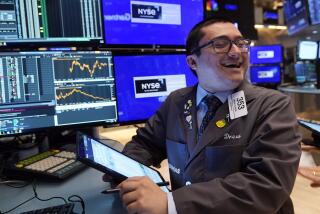Bad News Tests Nerves, but Small Investors Hold On
Reaction among individual investors to Monday’s big drop on Wall Street was an echo of the refrain heard so often during the 1990s bull market: We’re in it for the long haul.
Certainly, the yearlong stream of bad news from the markets is testing the nerves of many buy-and-hold investors. But most say they aren’t ready to push the panic button.
“It’s almost painful to wait it out,” said Kurt MacMillan, a 40-year-old Los Angeles auditor who says the constant up-and-down market over the last year has left his portfolio in the hole. “But that’s what you’ve got to do for a long-term payoff.”
That payoff got a bit farther away Monday. In one of the grimmest days yet for investors, the Nasdaq composite index closed below 2,000 for the first time since November 1998--more than 60% below its 5,048.62 high of a year ago. The Dow industrials added to last Friday’s sell-off with a 436-point loss, while the Standard & Poor’s 500 index plunged more than 4% to close in bear-market territory for the first time since 1990.
Financial advisors have long encouraged investors to avoid day-to-day stock swapping in favor of long-term investing--a strategy that was out of fashion a year ago at the height of the Nasdaq-fueled day-trading frenzy. For many individual investors, this approach still seems the best remedy--although that doesn’t make it any easier to deal with the pain of losing money in the market.
“It definitely hurts to watch,” said Hassan Adan, a 40-year-old state employee from Pasadena. “I don’t even open my financial statements anymore. I just don’t want to see the bad news.”
Daniel Pelc, 38, a lawyer from Minneapolis currently working in Los Angeles, knows the feeling. He racked up a $250,000 paper loss on a small technology stock that rose steadily for more than a year before plummeting. Now, Pelc says, he’s trying to ignore the market, but he’s not ready to cut out completely. Instead, he prefers to take a historical perspective.
“Every 10 years, the market goes through some dramatic shifts,” he said. “It’s cyclical. People who ride it out will see the long-term profits, people who don’t will suffer. . . . Remember, the market won’t drop forever.”
Aimee Hultman, 28, who works for a Los Angeles architecture firm, is also committed to staying the course. Though she’s concerned about the market’s gyrations, she continues to invest money regularly in her mutual fund.
“This is a cyclical thing. It will turn itself around eventually,” she said. “Now is the time to buy.”
John Miller, a 44-year-old civil engineer from Glendale, is also ready for the market to hit bottom. Miller, who has invested steadily in mutual funds and some stocks for several years, is preparing a list of companies to target for future buying opportunities.
“I want to find the companies that will lead us into the next bull market,” he said. “There’s still plenty of companies with strong sales out there.”
Miller is focusing on stable sectors such as banking and energy but is looking toward an upswing in new-technology and biotech stocks.
“Investors need to be aware of their goals and adjust their portfolios accordingly,” he said. “Sometimes it’s incredibly risky.”
Graham Allen, a fixed-income officer with Wells Capital Management of Los Angeles, acknowledges that investors should be concerned about the current state of the stock market--but not to the point of panic. The drop in the market is normal, he said, and eventually, it will rise again.
“If you have the money and the nerve, now is the time to buy,” he said. “You just might not want to watch.”
More to Read
Inside the business of entertainment
The Wide Shot brings you news, analysis and insights on everything from streaming wars to production — and what it all means for the future.
You may occasionally receive promotional content from the Los Angeles Times.









